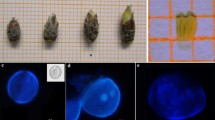Abstract
Based on a protocol for microspore culture in apple (Malus domestica Borkh.), the embryo induction phase has been improved with regard to pretreatment of microspores for initiation of microspore embryogenesis, the concentration of carbon source in the induction medium and the microspore density in the suspension. Furthermore, the effect of the genotype was studied. To determine the efficiency of in vitro androgenesis, both methods, via anther and microspore culture, were investigated using the same bud material. A comparison of the efficiency of embryo induction in anther and microspore cultures showed that microspore culture resulted in an increase up to 10 times, depending on the genotype. The regeneration route in microspore culture is similar to that of androgenic embryos via anther culture and showed adventitious shoot formation in most cases after a long period of secondary embryogenesis.





Similar content being viewed by others
References
Barro F, Martin A (1999) Response of different genotypes of Brassica carinata to microspore culture. Plant Breed 118:79–81
Bergen S van, Kottenhagen MJ, van der Meulen RM, Wang M (1999) The role of abscisic acid in induction of androgenesis: a comparative study between Hordeum vulgare L. Cvs. Igri and Digger. J. Plant Growth Regul 18:135–143
Bueno MA, Gomez A, Boscaiu M, Manzanera JA, Vincente O (1997) Stress-induced formation of haploid plants through anther culture in cork oak (Quercus suber). Physiol Plant 99:335–341
Carlson AR, Letarte J, Chen J, Kasha KJ (2001) Visual screening of microspore-derived transgenic barley (Hordeum vulgare L.) with green fluorescent protein. Plant Cell Rep 20:331–337
Chowdhury B, Mandal AB (2001) Microspore embryogenesis and fertile plantlet regeneration in a salt susceptible x salt tolerant rice hybrid. Plant Cell Tissue Organ Cult 65: 141–147
Fei KW, Xue GR (1981) Induction of haploid plantlets by anther culture in vitro in apple cv. 'Delicious'. Sci Agric Sin 4:41–44
Ferrie AMR, Taylor DC, MacKenzie SL, Keller WA (1999) Microspore embryogenesis of high sn-2 erucic acid Brassica oleracea germplasm. Plant Cell Tissue Organ Cult 57:79–84
Germana MA, Crescimanno FG, Motisi A (2000) Factors affecting androgenesis in Citrus clementina Hort. ex Tan. Adv Hortic Sci 14:43–51
Guha S, Maheshwari SC (1964) In vitro production of embryos from anthers of Datura. Nature 4957:497
Guha S, Maheshwari SC (1966) Cell division and differentiation of embryos in the pollen grains of Datura in vitro. Nature 5057:97–98
Guo Y-D, Pulli S (2000) An efficient androgenic embryogenesis and plant regeneration method through isolated microspore culture in timothy (Phleum pratense L.). Plant Cell Rep 19:761–767
Hansen M (2000) ABA Treatment and desiccation of microspore-derived embryos of cabbage (Brassica oleracea ssp. capitata L.) Improves plant development. J Plant Physiol 156:164–167
Heslop-Harrison J, Heslop-Harrison Y (1970) Evaluation of pollen viability by enzymatically induced fluorescence: Intracellular hydrolysis of fluorecein diacetate. Stain Technol 45:115–120
Höfer M (1995) In-vitro-Androgenese bei Apfel. Gartenbauwissenschaft 60:12–15
Höfer M (1997) In vitro androgenesis in apple: optimization of the anther culture. Acta Hortic 447:341–344
Höfer M, Hanke V (1990) Induction of androgenesis in vitro in apple and sweet cherry. Acta Hortic 280:333–336
Höfer M, Hanke V (1994) Antherenkultur bei Apfel und Kirsche: Einfluß des Pollenentwicklungsstadiums—Korrelative Beziehungen zu morphologischen Blütenmerkmalen. Gartenbauwissenschaft 59:225–228
Höfer M, Lespinasse Y (1996) Haploidy in apple. In: Jain SM, Sopory SK, Veilleux RE (eds) In vitro haploid production in higher plants, vol 3. Kluwer, Dordrecht, pp 259–274
Höfer M, Touraev A, Heberle-Bors E (1999) Induction of embryogenesis from isolated apple microspores. Plant Cell Rep 18:1012–1017
Hoekstra S, van Zijderveld MH, Louwerse JD, Heidekamp F, van der Mark F (1992) Anther and microspore culture of Hordeum vulgare L. cv. Igri. Plant Sci 86:89–96
Hoekstra S, van Zijderveld MN, Heidekamp F, van der Mark F (1993) Microspore culture of Hordeum vulgare L.: the influence of density and osmolality. Plant Cell Rep 12: 661–665
Huang B, Bird S, Kemble R, Simmonds D, Keller W, Miki B (1990) Effects of culture density, conditioned medium and feeder cultures on microspore embryogenesis in Brassica napus L. cv. Topas. Plant Cell Rep 8:594–597
Jähne A, Lörz H (1995) Cereal microspore culture. Plant Sci 109:1–12
Jain SM, Sopory SK, Veilleux RE (1996) In vitro haploid production in higher plants, vol 2. Applications. Kluwer, Dordrecht
Kunz C, Islam SMS, Berberat J, Peter SO, Büter B, Stamp P, Schmid JE (2000) Assessment and Improvement of wheat microspore derived embryo induction and regeneration. J Plant Physiol 156:190–196
Kyo M, Harada H (1986) Control of the developmental pathway of tobacco pollen in vitro. Planta 168:427–432
Murashige T, Skoog F (1962) A revised medium for rapid growth and bioassays with tobacco tissue cultures. Physiol Plant 15:473–497
Pescitelli SM, Johanson CD, Petolino JF (1990) Isolated microspore culture of maize: effects of isolation technique, reduced temperature, and sucrose level. Plant Cell Rep 8: 628–631
Ryan AB, Castillo AM, Valles MP, Sanz JM, Cistue L (1999) Desiccated doubled-haploid embryos obtained from microspore culture of barley cv. Igri. Plant Cell Rep 18: 924–928
Siebel J, Pauls KP (1989) A comparison of anther and microspore culture as a breeding tool in Brassica napus. Theor Appl Genet 78:473–479
Touraev A, Indrianto A, Wratschko I, Vicente O, Heberle-Bors E (1996) Efficient microspore embryogenesis in wheat (Triticum aestivum L.) induced by starvation at high temperatures. Sex Plant Reprod 9:209–215
Touraev A, Stöger E, Voronin V, Heberle-Bors E (1997) Plant male germ line transformation. Plant J 12:949–956
Xue GR, Niu JZ (1984) A study on the induction of apple pollen plants. Acta Hortic Sin 11:161–164
Acknowledgements
I am grateful to Prof. E. Heberle-Bors and to Dr. A. Touraev for the opportunity to learn the method of microspore culture in tobacco and wheat in their laboratory during a short-term scientific mission of COST Action 824. I thank S. Schöber and R. Gläß for technical assistance in microspore culture.
Author information
Authors and Affiliations
Corresponding author
Additional information
Communicated by H. Lörz
Rights and permissions
About this article
Cite this article
Höfer, M. In vitro androgenesis in apple—improvement of the induction phase. Plant Cell Rep 22, 365–370 (2004). https://doi.org/10.1007/s00299-003-0701-y
Received:
Revised:
Accepted:
Published:
Issue Date:
DOI: https://doi.org/10.1007/s00299-003-0701-y




